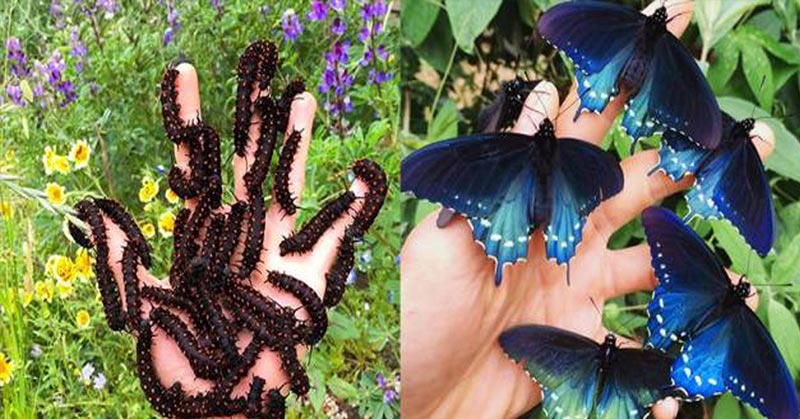The California Pipevine Swallowtail (Battus philenor hirsuta) is one of the most beautiful butterfly species in the world. With iridescent color tones and a vampire-like appearance, the caterpillar blossoms into an adult fly with stunning black forewings and hindwings spun with twilight blue hues and sea-sand beige that you could stare at for days.
Native to San Francisco, these butterflies are found in many habitats but mostly in forests. Urbanization caused a decline of these insects in San Francisco starting in the early 1900s. Today, they are rarely seen in the city, but when they are spotted, they are a sight for sore eyes. Their unique color patterns would certainly stand out in any brightly-lit space. These insects took refuge in rural areas around the city, seeking habitats in places with thick vegetation and better environmental conditions.
However, they were the pride of San Francisco and they needed to be brought home.
28-year-old Tim Wong, an aquatic biologist who works at the California Academy of Sciences has been a butterfly enthusiast since he was a kid. He was intrigued by the stages of metamorphosis in a biology class and he’s been hooked ever since. The Pipevine butterfly had begun to decline in San-F long before his time, but he found out about them a few years ago and amazingly, they’ve become one of his life missions. A mission he’s done an astounding job at so far.
The perfect man-crafted natural habitat
Wong took a lot of time to gather information about the butterflies, and he began to set things in place to give them the most natural habitat possible. He discovered that while in the caterpillar stage, the insects would only feed on the California pipevine, a rare woody vine native to North America.
In an interview with Vox, Wong said he was able to locate the plant in a research garden and was lucky to get some samples of it [1]. He then set to work in his backyard and turned it into a botanical garden of his own.
“Finally, I was able to find this plant in the San Francisco Botanical Garden [in Golden Gate Park],” Wong said. “And they allowed me to take a few clippings of the plant. [I built] a large screen enclosure to protect the butterflies and to allow them to mate under outdoor environmental conditions — natural sun, airflow, temp fluctuations. The specialized enclosure protects the butterflies from some predators, increases mating opportunities, and serves as a study environment to better understand the criteria female butterflies are looking for in their ideal host plant.”
Wong is not the first person who tried to bring the butterflies back to San Francisco. Barbara Deutsch attempted to repopulate the species in the ’80s, but they migrated again after a while. Wong believes that he’s been able to keep the butterflies in place due to the amazing habitat he built for them. He’s spent 7 years growing over 200 California pipevine plants, along with other floral species to provide adequate nectar for these insects.
According to Wong, he began the process with a slow-and-steady approach, trying not to overcrowd the mini vegetation. He’d introduce only about a hundred at a time, giving them enough room to blossom before he’d increase the population intake. Wong says that last year alone, he brought in thousands of caterpillars to his garden.
“Each year since 2012, we’ve seen more butterflies surviving in the garden, flying around, laying eggs, successfully pupating, and emerge the following year,” he says. “That’s a good sign that our efforts are working!”
The breeding process
His first set of Swallowtails were larvae he was able to collect with permission from people’s homes. He watched them every day in his backyard, observing their feeding habits, stages of metamorphosis, final blossoming, mating, and egg-laying.
“They feed as a little army,” he says. “They roam around the pipevine plant from leaf to leaf, munching on it as a group.”
Monitoring the rates of diapause in the insects enabled Wong to further condition his garden to suit their environmental needs. At 3-4 weeks, the caterpillar would morph into a pupa with hard shells in which the liquefaction process would take place. At this point, two things could happen. If the external conditions are favorable, the butterfly would morph into a magnificent adult in two weeks, otherwise, it would remain in its chrysalis for up to two years before blossoming.
However, they could emerge from diapause as adults in a shorter period, usually in the spring. The insects have a short life span of about two to five weeks, depending on temperature and other physical factors. Wong is so dedicated to his butterfly garden that he incubates the eggs indoors to protect from predators such as spiders, lizards, and other egg-loving crawlers.
Wong loves his work, but he explains that it’s a tedious one that requires a lot of attention, time, energy, funds, and most importantly, passion.
Not many people can take on a solo repopulation mission. However, Wong believes that everyone can contribute easily by planting pipevine and other native flora to give the butterflies a better chance of staying in San Francisco for good this time.
“Improving habitat for native fauna is something anyone can do,” Wong says. “Conservation and stewardship can start in your very own backyard.”
- Crockett, Zachary. How one man repopulated a rare butterfly species in his backyard. Vox. https://www.vox.com/2016/7/6/12098122/california-pipevine-swallowtail-butterfly-population. Retrieved 23-07-19
- Admin. California Pipevine and California Dutchman’s Pipe. Las Pilitas. https://www.laspilitas.com/nature-of-california/plants/90–aristolochia-californica. Retrieved 23-07-19
- Denlinger, David. Diapause. Science Direct. https://www.sciencedirect.com/topics/agricultural-and-biological-sciences/diapause. Retrieved 23-07-19

